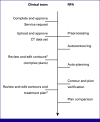Addressing the Global Expertise Gap in Radiation Oncology: The Radiation Planning Assistant
- PMID: 37471671
- PMCID: PMC10581646
- DOI: 10.1200/GO.22.00431
Addressing the Global Expertise Gap in Radiation Oncology: The Radiation Planning Assistant
Abstract
Purpose: Automation, including the use of artificial intelligence, has been identified as a possible opportunity to help reduce the gap in access and quality for radiotherapy and other aspects of cancer care. The Radiation Planning Assistant (RPA) project was conceived in 2015 (and funded in 2016) to use automated contouring and treatment planning algorithms to support the efforts of oncologists in low- and middle-income countries, allowing them to scale their efforts and treat more patients safely and efficiently (to increase access).
Design: In this review, we discuss the development of the RPA, with a particular focus on clinical acceptability and safety/risk across jurisdictions as these are important indicators for the successful future deployment of the RPA to increase radiotherapy availability and ameliorate global disparities in access to radiation oncology.
Results: RPA tools will be offered through a webpage, where users can upload computed tomography data sets and download automatically generated contours and treatment plans. All interfaces have been designed to maximize ease of use and minimize risk. The current version of the RPA includes automated contouring and planning for head and neck cancer, cervical cancer, breast cancer, and metastases to the brain.
Conclusion: The RPA has been designed to bring high-quality treatment planning to more patients across the world, and it may encourage greater investment in treatment devices and other aspects of cancer treatment.
Conflict of interest statement
The following represents disclosure information provided by authors of this manuscript. All relationships are considered compensated unless otherwise noted. Relationships are self-held unless noted. I = Immediate Family Member, Inst = My Institution. Relationships may not relate to the subject matter of this manuscript. For more information about ASCO's conflict of interest policy, please refer to
Open Payments is a public database containing information reported by companies about payments made to US-licensed physicians (
Figures




References
-
- Atun R, Jaffray DA, Barton MB, et al. Expanding global access to radiotherapy. Lancet Oncol. 2015;16:1153–1186. - PubMed
-
- Farmer P, Frenk J, Knaul FM, et al. Expansion of cancer care and control in countries of low and middle income: A call to action. Lancet. 2010;376:1186–1193. - PubMed
-
- Netherton TJ, Cardenas CE, Rhee DJ, et al. The emergence of artificial intelligence within radiation oncology treatment planning. Oncology. 2021;99:124–134. - PubMed
-
- Cardenas CE, Yang J, Anderson BM, et al. Advances in auto-segmentation. Semin Radiat Oncol. 2019;29:185–197. - PubMed
Publication types
MeSH terms
Grants and funding
LinkOut - more resources
Full Text Sources
Medical
Miscellaneous

